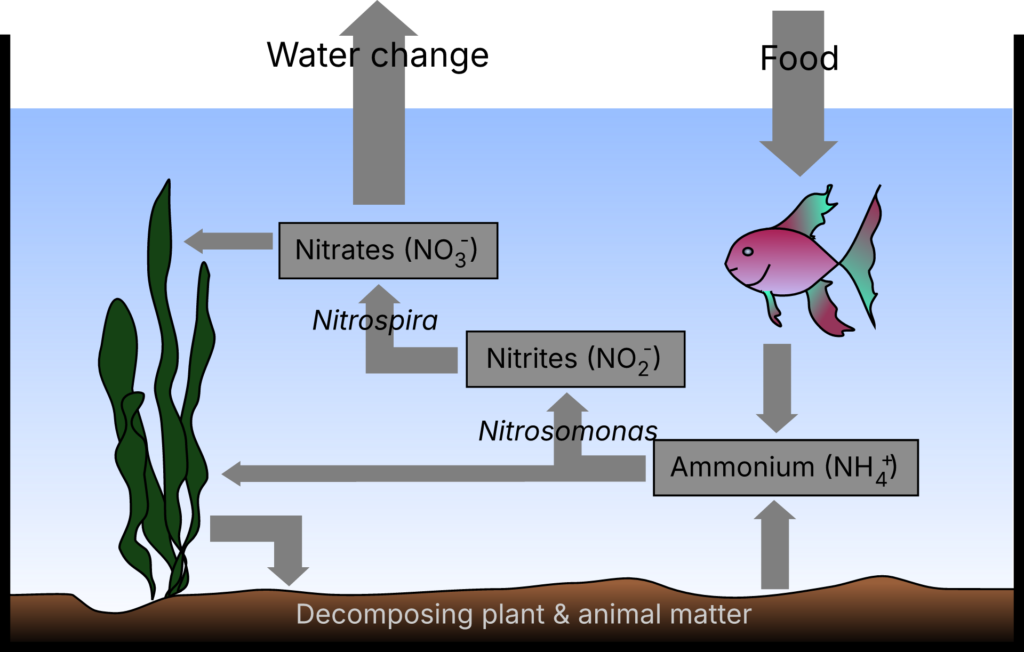

The nitrogen cycle is a fundamental process that underpins the health and stability of any aquarium ecosystem. Understanding this cycle is crucial for both novice and experienced aquarists, as it directly impacts the well-being of aquatic life. The nitrogen cycle refers to the biological process through which nitrogen compounds are converted into various forms, ultimately leading to a stable environment for fish and other inhabitants.
This cycle is not only vital for maintaining water quality but also for ensuring that the aquarium remains a thriving habitat for its residents. In an aquarium, the nitrogen cycle begins with the introduction of organic waste, uneaten food, and fish excretions, all of which release ammonia into the water. Ammonia is highly toxic to fish and can lead to severe health issues or even death if not managed properly.
Therefore, understanding how the nitrogen cycle operates and how to maintain it is essential for any aquarist looking to create a sustainable aquatic environment. This article will delve into the intricacies of the nitrogen cycle, its stages, the role of beneficial bacteria, and practical tips for maintaining a healthy aquarium.
Key Takeaways
- The nitrogen cycle is a crucial process in aquariums that helps maintain water quality and the health of aquatic life.
- Nitrogen plays a key role in the aquarium ecosystem, with ammonia, nitrite, and nitrate being the three main stages of the nitrogen cycle.
- Beneficial bacteria are essential for breaking down harmful nitrogen compounds and converting them into less toxic forms.
- Regular water testing and maintenance are important for managing the nitrogen cycle and preventing common issues such as ammonia spikes and nitrate buildup.
- When cycling a new aquarium, it’s important to establish the nitrogen cycle properly and monitor water parameters closely to ensure a healthy environment for fish and other aquatic organisms.
Understanding Nitrogen and its Role in the Aquarium Ecosystem
The Nitrogen Cycle
Each of these compounds has distinct characteristics and impacts on aquatic life, making it crucial for aquarists to understand their roles within the ecosystem.
Ammonia, often introduced into the aquarium through fish waste and decaying organic matter, is the first form of nitrogen encountered in the nitrogen cycle.
It is highly toxic to fish and can lead to stress or death if concentrations rise too high.
The Conversion Process
As ammonia levels increase, beneficial bacteria begin to thrive, converting ammonia into nitrite—a less toxic but still harmful compound. Eventually, another group of bacteria transforms nitrite into nitrate, which is significantly less harmful to fish and can be utilized by aquatic plants as a nutrient source.
Maintaining a Balanced Aquarium Environment
This transformation process is vital for maintaining a balanced aquarium environment. By understanding the nitrogen cycle and the roles of ammonia, nitrite, and nitrate, aquarists can take steps to create a healthy and thriving ecosystem for their aquatic life.
The Three Stages of the Nitrogen Cycle: Ammonia, Nitrite, and Nitrate


The nitrogen cycle consists of three primary stages: ammonia production, nitrite conversion, and nitrate formation. Each stage plays a critical role in ensuring that the aquarium remains a safe habitat for its inhabitants. The first stage begins with the introduction of ammonia into the water.
This can occur through various means, including fish waste, uneaten food, and decaying plant matter. Ammonia is highly toxic to fish and can cause severe health issues if allowed to accumulate. As ammonia levels rise, beneficial bacteria known as Nitrosomonas begin to flourish in the aquarium environment.
These bacteria convert ammonia into nitrite through a process called nitrification. While nitrite is less toxic than ammonia, it can still pose a significant threat to fish if present in high concentrations. The second stage of the nitrogen cycle is crucial for reducing the toxicity of the water and ensuring that fish can thrive.
The final stage of the nitrogen cycle involves the conversion of nitrite into nitrate by another group of beneficial bacteria known as Nitrobacter. Nitrate is far less harmful to fish and can even serve as a nutrient source for aquatic plants. However, excessive nitrate levels can lead to algae blooms and other water quality issues if not managed properly.
Regular water changes and plant maintenance are essential for keeping nitrate levels in check and ensuring a balanced ecosystem.
Beneficial Bacteria and their Role in the Nitrogen Cycle
Beneficial bacteria are the unsung heroes of the nitrogen cycle in aquariums. These microorganisms play a vital role in breaking down harmful compounds and converting them into less toxic forms that can be safely managed within the ecosystem. The two primary groups of bacteria involved in this process are Nitrosomonas and Nitrobacter.
Each group specializes in a specific stage of the nitrogen cycle, working together to maintain water quality and support aquatic life. Nitrosomonas bacteria are responsible for converting ammonia into nitrite during the first stage of the nitrogen cycle. These bacteria thrive in oxygen-rich environments, making them well-suited for life in an aquarium’s filter media and substrate.
As they consume ammonia, they multiply rapidly, helping to reduce toxic levels in the water. The presence of these bacteria is crucial for establishing a stable environment where fish can thrive without fear of ammonia poisoning. Once nitrite levels begin to rise, Nitrobacter bacteria take over by converting nitrite into nitrate during the second stage of the nitrogen cycle.
Like their counterparts, these bacteria also prefer oxygen-rich environments and are commonly found in filter media and substrate. By facilitating this conversion process, Nitrobacter helps ensure that nitrate levels remain manageable within the aquarium ecosystem. Together, these beneficial bacteria form a symbiotic relationship that is essential for maintaining a healthy nitrogen cycle.
Maintaining a Healthy Nitrogen Cycle in Your Aquarium
Maintaining a healthy nitrogen cycle in your aquarium requires diligence and attention to detail. One of the most effective ways to ensure that beneficial bacteria thrive is by providing them with an appropriate environment. This includes ensuring adequate oxygen levels through proper filtration and aeration.
A well-functioning filter not only removes physical debris but also provides a habitat for beneficial bacteria to colonize. Regular water changes are another critical aspect of maintaining a healthy nitrogen cycle. While beneficial bacteria help convert harmful compounds into less toxic forms, they cannot eliminate them entirely.
Performing routine water changes helps dilute concentrations of ammonia, nitrite, and nitrate, preventing them from reaching harmful levels. Additionally, incorporating live plants into your aquarium can further assist in managing nitrate levels, as they utilize this compound as a nutrient source. Monitoring water parameters is also essential for maintaining a healthy nitrogen cycle.
Regular testing for ammonia, nitrite, and nitrate levels will help you identify any potential issues before they escalate into serious problems. If you notice elevated levels of ammonia or nitrite, it may indicate that your beneficial bacteria are not thriving or that your aquarium is overstocked. Taking corrective measures promptly can help restore balance to your aquarium ecosystem.
Common Issues and Problems with the Nitrogen Cycle in Aquariums
Introduction to Nitrogen Cycle Issues
Despite best efforts, aquarists may encounter various issues related to the nitrogen cycle that can jeopardize the health of their aquatic inhabitants. One common problem is an ammonia spike, which can occur due to overfeeding, inadequate filtration, or introducing too many fish too quickly without allowing time for beneficial bacteria to establish themselves. An ammonia spike can lead to severe stress or even death among fish if not addressed promptly.
Ammonia and Nitrite Imbalance
Another issue that may arise is elevated nitrite levels, which can occur if there is an imbalance between ammonia production and bacterial conversion rates. If Nitrosomonas bacteria are not thriving or if there are insufficient numbers to handle the ammonia load, nitrite levels can rise dangerously high. This situation often requires immediate action, such as performing partial water changes or adding additional filtration to support bacterial growth.
Nitrate Accumulation and Management
Nitrate accumulation can also become problematic if not managed properly. While nitrate is less toxic than ammonia or nitrite, excessive levels can lead to algae blooms and poor water quality. Regular water changes and maintaining a balanced bioload within the aquarium are essential strategies for preventing nitrate buildup and ensuring a healthy environment for aquatic life.
Prevention and Maintenance
To prevent these issues, it is crucial for aquarists to monitor their aquarium’s water parameters closely and take proactive measures to maintain a balanced ecosystem.
By understanding the nitrogen cycle and taking steps to prevent ammonia spikes, nitrite imbalances, and nitrate accumulation, aquarists can create a healthy and thriving environment for their aquatic inhabitants.
Tips for Cycling a New Aquarium and Establishing the Nitrogen Cycle
Cycling a new aquarium is one of the most critical steps in establishing a healthy aquatic environment. The process involves allowing beneficial bacteria to colonize within the tank before introducing fish or other inhabitants. One effective method for cycling an aquarium is known as “fishless cycling,” which involves adding an ammonia source—such as pure ammonia or decomposing organic matter—to stimulate bacterial growth without subjecting fish to harmful conditions.
During this cycling process, it is essential to monitor water parameters regularly. Testing for ammonia, nitrite, and nitrate levels will help you track progress and determine when beneficial bacteria have established themselves effectively. Typically, you will observe an initial spike in ammonia followed by an increase in nitrite levels before finally seeing nitrate accumulation as beneficial bacteria convert these compounds.
Once you have established a stable nitrogen cycle with detectable levels of nitrate but no ammonia or nitrite present, it is safe to introduce fish gradually. Start with a small number of hardy species that can tolerate slight fluctuations in water quality as you continue monitoring parameters closely during this transition period.
The Importance of Regular Water Testing and Maintenance in Managing the Nitrogen Cycle
Regular water testing and maintenance are paramount in managing the nitrogen cycle effectively within your aquarium. By routinely checking parameters such as ammonia, nitrite, nitrate, pH, and temperature, you can gain valuable insights into your tank’s overall health and make informed decisions regarding maintenance practices. This proactive approach allows you to identify potential issues before they escalate into serious problems that could jeopardize your aquatic inhabitants’ well-being.
In addition to testing water parameters regularly, performing routine maintenance tasks—such as partial water changes—helps keep harmful compounds at bay while promoting a stable environment for beneficial bacteria to thrive. Water changes dilute concentrations of ammonia, nitrite, and nitrate while replenishing essential minerals that may be depleted over time due to biological processes within the tank. Ultimately, understanding and managing the nitrogen cycle is crucial for any aquarist seeking to create a thriving aquatic ecosystem.
By prioritizing regular testing and maintenance practices alongside fostering beneficial bacterial growth through proper filtration techniques and bioload management strategies, you can ensure that your aquarium remains a safe haven for its inhabitants while enjoying the beauty and tranquility that comes with maintaining an aquatic environment.
FAQs
What is the nitrogen cycle for aquariums?
The nitrogen cycle is the process by which beneficial bacteria convert toxic ammonia from fish waste and decaying organic matter into less harmful compounds, ultimately maintaining a healthy and balanced aquatic environment in aquariums.
Why is the nitrogen cycle important for aquariums?
The nitrogen cycle is crucial for aquariums as it helps to maintain water quality by breaking down and removing harmful ammonia and nitrite, which can be toxic to fish and other aquatic organisms.
What are the stages of the nitrogen cycle in aquariums?
The nitrogen cycle in aquariums consists of three main stages: 1) Ammonia is produced from fish waste and decaying organic matter, 2) Beneficial bacteria convert ammonia into nitrite, and 3) Another group of beneficial bacteria convert nitrite into nitrate, which is less harmful to aquatic life.
How can the nitrogen cycle be established in a new aquarium?
To establish the nitrogen cycle in a new aquarium, beneficial bacteria need to colonize the filter media, substrate, and other surfaces within the tank. This can be achieved by adding a source of ammonia, such as fish food or pure ammonia, and allowing the bacteria to develop over several weeks.
How can the nitrogen cycle be maintained in an established aquarium?
In an established aquarium, the nitrogen cycle can be maintained by regularly testing water parameters, performing partial water changes, avoiding overfeeding, and ensuring a healthy population of beneficial bacteria in the filter and substrate.











